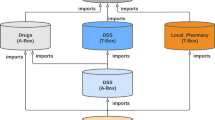Abstract
Clinical Pathways (CP) enhance the quality of patient care, and are thus important in health management. However, there is a need to address the challenge of adaptation of treatment procedures in CP—that is, the treatment schemes must be re-modified once the clinical status and other care conditions of patients in the healthcare setting change, which happen frequently. In addition, the widespread and frequent use of Electronic Medical Records (EMR) implies an increasing need to combine CP with other healthcare information systems, especially EMR, in order to greatly improve healthcare quality and efficiency. This study proposed an ontology-based method to model CP: ontology was used to model CP domain terms; Semantic Web Rule language was used to model domain rules. In this way, the CP could reason over the rules, knowledge, and information collected, and provides automated error checking for the next steps of the treatment in runtime, which is adaptive to treatment procedures. To evaluate our method, we built a Lobectomia Pulmonalis CP and realized it based on an EMR system.





Similar content being viewed by others
References
Rotter, T., Kinsman, L., James, E. L., Machotta, A., Gothe, H., Willis, J., Snow, P., and Kugler, J., Clinical pathways: Effects on professional practice, patient outcomes, length of stay and hospital costs. Cochrane Database Syst. Rev. 2010, Issue 3. Art. No.: CD006632. doi:10.1002/14651858.CD006632.pub2.
Cheal, J., Development and implementation of a clinical pathway programme in an acute care general hospital in Singapore. Int. J. Qual. Health Care 12:403–412, 2000.
Loeb, M., Carusone, S., Goeree, R., Walter, S., Brazil, K., Krueger, P., Simor, A., Moss, L., and Marrie, T., Effect of a clinical pathway to reduce hospitalizations in nursing home residents with Pneumonia. J. Am. Assoc. 295(21):2503–2510, 2006.
Madan, A. K., Speck, K. E., Ternovits, C. A., and Tichansky, D. S., Outcome of a clinical pathway for discharge within 48 hours after laparoscopic gastric bypass. Am. J. Surg. 192(3):399–402, 2006.
Hauck, L. D., Adler, L. M., and Mulla, Z. D., Clinical pathways care improves outcomes among patients hospitalized for community-acquired pneumonis. Ann. Epidemiol. 14:669–675, 2000.
Alexandrou, D., Xenikoudakis, F., and Mentzas, G., SEMPATH: Semantic adaptive and personalized clinical pathways. Int. Conf. eHealth Telemed. Soc. Med.:36–41, 2009.
Abidi, S., and Chen, H., Adaptable personalized care planning via a semantic web framework. 20th International congress of the European federation of medical informatics. Ios Press, Maastricht, 2006.
Okada, O., Ohboshi, N., Kuroda, T., Nagase, K., and Yoshihara, H., Electronic clinical path system based on semistructured data model using personal digital assistant for onsite Access. J. Med. Syst. 29(4):379–389, 2005.
Okada, O., Ohboshi, N., Kuroda, T., Nagase, K., and Yoshihara, H., Clinical pathways modeling in XML for a web-based benchmark test system for medicine. J. Med. Syst. 29(5):539–553, 2005.
Ye, Y., Jiang, Z., Diao, X., Yang, D., and Gu, G., An ontology-based hierarchical semantic modeling approach to clinical pathway workflows. Comput. Biol. Med. 39:722–732, 2009.
Li, J., Zhang, X., Chu, J., Suzuki, M., and Araki, K., Design and development of EMR supporting medical process management. J. Med. Syst., 2010. Accepted
Chu, S., and Cesnik, B., Improving clinical pathway design: Lessons learned from a computerized prototype. Int. J. Med. Inform. 51:1–11, 1998.
Lee, C. S., and Wang, M. H., Ontology-based intelligent healthcare agent and its application to respiratory waveform recognition. Expert Syst. Appl. 33:606–619, 2007.
O’Connor, M. J., Shankar, R. D., Parrish, D. B., and Das, A. K., Knowledge-data integration for temporal reasoning in a clinical trial system. Int. J. Med. Inform., Volume 78, Supplement 1, MedInfo 2007, April 2009, Pages S77–S85, ISSN 1386–5056. doi:10.1016/j.ijmedinf.2008.07.013.
Argüello, M., and Des, J., Clinical practice guidelines: A case study of combining OWL-S, OWL, and SWRL. Appl. Innov. Intell. Syst. XV 2:19–32, 2008. doi:10.1007/978-1-84800-086-5_2.
Chi, Y., Rule-based ontological knowledge base for monitoring partners across supply networks. Expert Syst. Appl. 37:1400–1407, 2010.
OWL Web Ontology Language Reference, http://www.w3.org/TR/owl-ref/. Last date visited: 2010-1-10.
SWRL Semantic Web Rule Language, http://www.w3.org/Submission/SWRL/. Last date visited: 2010-1-10.
Uschold, M., and Jasper, R., A framework for understanding and classifying ontology application. Procedings of the IJCAI-99 workshop in Ontologies and problem-solving methods. Sweden, 1999.
Atkinson-Abutridy, J. A., A domain-independent approach to discourse-level knowledge discovery from texts. Lect. Notes Comput. Sci. 3533:470–479, 2005.
Abidi, S. R., A concept framework for ontology based automating and merging of clinical pathways of comorbidities. Knowledge management for health care procedures. Lect. Notes Comput. Sci. 5626(2009):55–66, 2009. doi:10.1007/978-3-642-03262-2_5.
Uschold, M., and Gruninger, M., Ontologies: Principles, methods and applications. Knowl. Eng. Rev. 11:93–155, 1996.
National Referral Guidelines, http://www.eyenz.com/provider_info/Ophthalmology_CPAC.pdf. Last date visited: 2011-01-10.
O’Connor, M. J., Tu, S. W., Nyulas, C. I., Das, A. K., and Musen, M. A., Querying the semantic web with SWRL. Advances in rule interchange and applications. Lect. Notes Comput. Sci. 4824(2007):155–159, 2007. doi:10.1007/978-3-540-75975-1_13.
Acknowledgements
This research is supported by the Fundamental Research Funds for the Central Universities and by National High-tech R&D Program (No. 2009AA045300).
Author information
Authors and Affiliations
Corresponding author
Rights and permissions
About this article
Cite this article
Hu, Z., Li, JS., Zhou, TS. et al. Ontology-Based Clinical Pathways with Semantic Rules. J Med Syst 36, 2203–2212 (2012). https://doi.org/10.1007/s10916-011-9687-0
Received:
Accepted:
Published:
Issue Date:
DOI: https://doi.org/10.1007/s10916-011-9687-0




